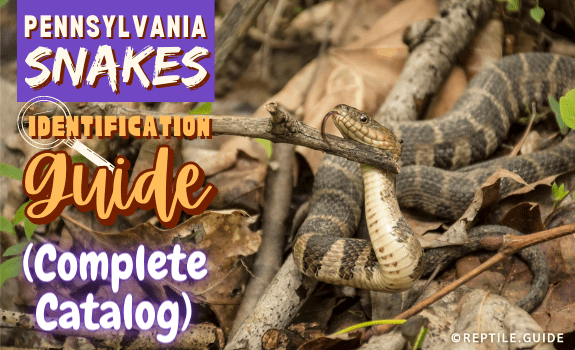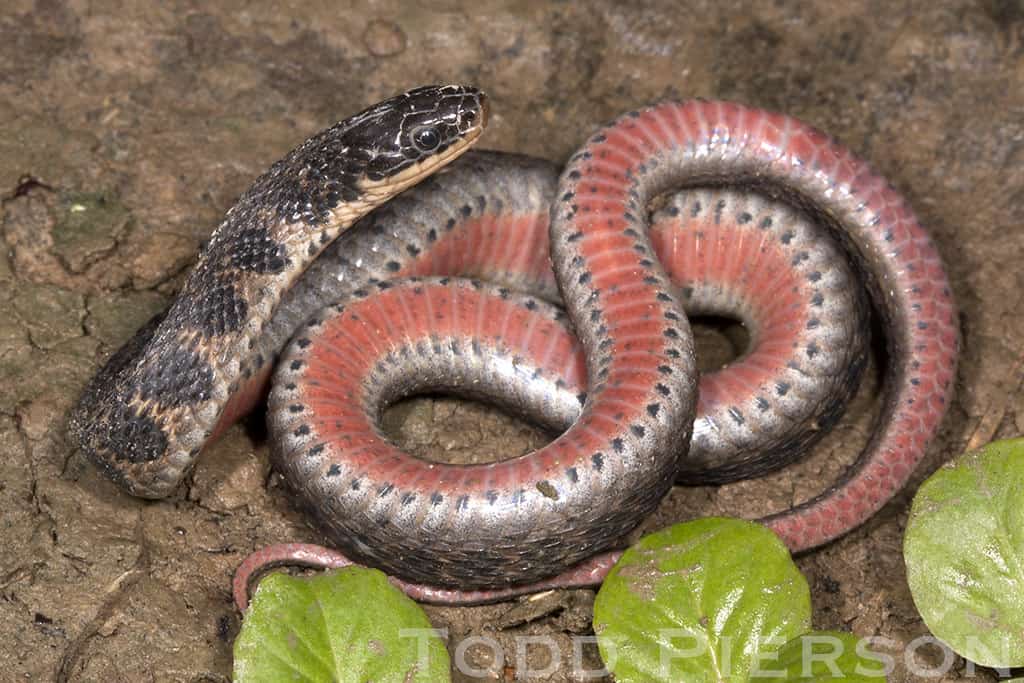Having the ability to identify wild snakes in your area is an important skill set to possess.
Knowing whether you’re facing a harmless snake like the Eastern Milk Snake, or a venomous snake like the Eastern Copperhead, can help you avoid a potentially dangerous situation.
There are 21 species of Pennsylvania snakes, three of which are venomous.
This guide will assist you in learning how to identify the most common, most dangerous, and rarest snakes in Pennsylvania.
You’ll discover how to co-exist with wild snakes, what to do if you meet one, and who to contact for emergency advice, snake removal, and additional information.
In This Article
In Short
- If you see a snake in the wild, respect its space.
- Snakes are essential features of the PA ecosystem.
- All three venomous snake species in the state are pit vipers.
- The most common snakes in PA are the Eastern Garter Snake, and Northern Watersnake.
- Most snake bites happen when someone is trying to kill, relocate, or harass a snake in some way.
- There are three endangered snake species in PA; The Eastern Massasauga, Kirtland’s Snake, and Northern Rough Greensnake.
PA Snake Identification Basics
This guide is only for Pennsylvania snake identification.
Snake appearances often vary based on habitat and geographic location.
Even within populations, there are aberrant snakes (ones that appear different from a typical snake of that species).
Some of the most useful elements to consider when you come across a snake are:
- Size – If you find a large snake, you can be certain it isn’t an Eastern worm snake, for example. The patterns of a copperhead and an Eastern milk snake may appear similar at a glance, but their size differences help set them apart.
- Color – A bright green snake, like the smooth green snake, definitely can’t be confused with a timber rattlesnake.
- Location – Some species live in specialized habitats, and you’ll only find them in particular areas of the state.
- Pupil shape – All of the venomous species in PA have elliptical-shaped pupils, while the harmless ones have round pupils.
Many snakes have similar patterns and coloration that can be problematic when attempting to identify them.
You’re most likely to correctly ID a snake when incorporating all of these aspects together.
Quickly Identifying Venomous Species
There are three venomous species in Pennsylvania.
Some of them are easy to mistake for one of the many harmless species throughout the state.
Fortunately, Pennsylvania’s most dangerous snakes are closely related and share several distinguishing characteristics.
I’ll cover the best ways to differentiate a harmless snake from a venomous one, and go over each venomous species in detail below.
If you have doubts about a snake’s identity, you should always err on the side of caution.
All Venomous Snakes in Pennsylvania Are Pit Vipers
All three species of venomous snakes in Pennsylvania are members of the Viperidae family.
These venomous pit vipers can be distinguished from harmless species in the state by several mutual characteristics:
- Elliptical pupils
- Heat-sensing pits
- Broad, triangle-shaped heads
These three species have elliptical-shaped pupils, like a cat’s eyes, while all nonvenomous snakes in PA have round pupils.
You’ll also find sensory pits between their eyes and nostrils. These detect heat and assist them in locating prey.
The head of a pit viper is a well-defined triangle shape due to the location of the venom glands on each side.
Some harmless snakes will puff up their head and neck when they feel threatened, which can be deceiving to humans and other predators.
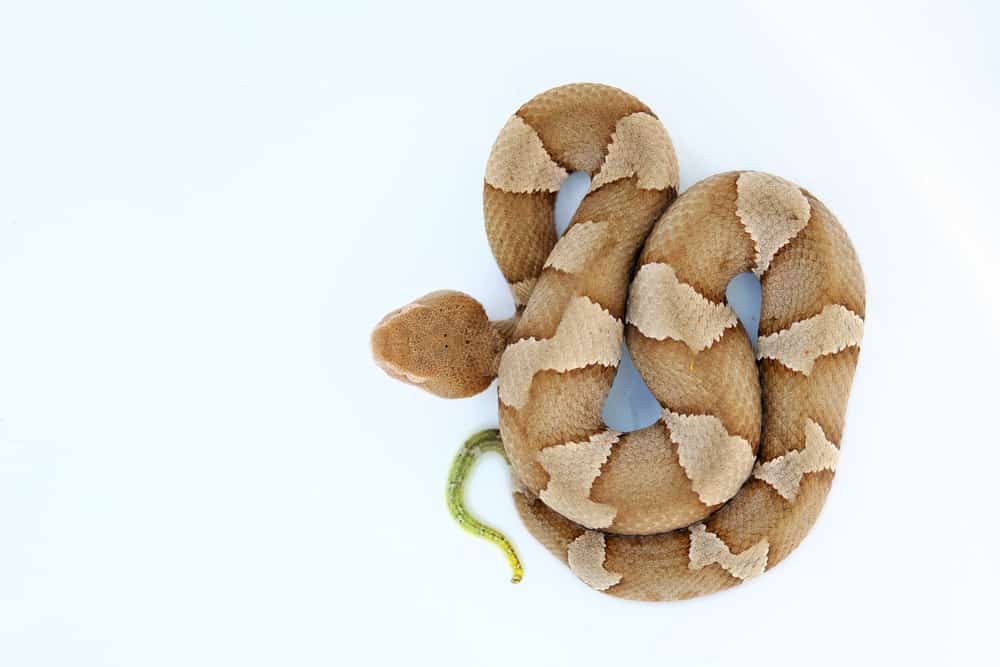
These characteristics are most obvious at close range, so please be cautious when looking for them.
Northern Copperhead
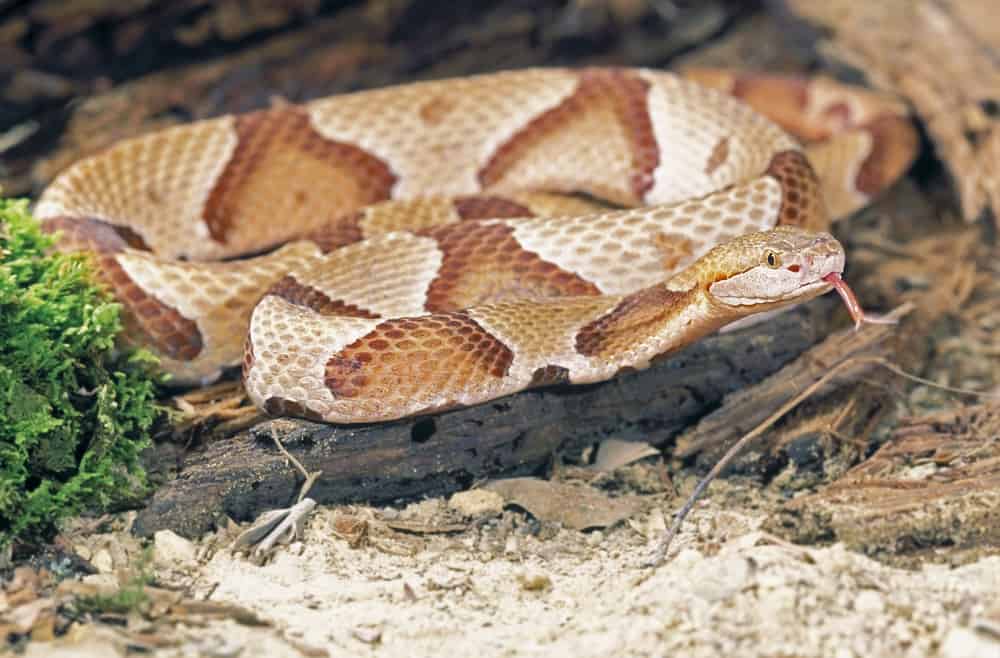
|
Scientific Name: |
Eastern Copperhead Agkistrodon contortrix Agkistrodon contortrix mokasen Northern Copperhead subspecies |
|
Range: |
Statewide except for the northern border of Pennsylvania |
|
Size: |
24-36 inches |
|
Description: |
Keeled scales Heavy-bodied Elliptical pupils on a large triangle-shaped head Copper brown head and a tan, pinkish-brown, or grayish-brown body Hourglass or saddle-shaped brown bands down the length of the body Juveniles have similar coloration as adults, except for yellow or green-tipped tails |
|
Habitat: |
Forests, rocky hillsides, open habitats, sometimes near sources of water |
|
Diet: |
Mice, birds, lizards, amphibians, insects, and small snakes |
|
Venomous/Non-Venomous: |
Venomous |
The copperhead is the most common venomous snake in PA.
People often misidentify Northern water snakes and Eastern milk snakes as copperheads.
The most notable difference between these species:
|
Species |
Pupils |
Head Shape |
Pattern |
|
Northern Copperhead |
Elliptical pupils |
Triangle head |
Hourglass-shaped bands narrow in the center of the back and widen towards the sides, solid copper-colored head |
|
Northern Water Snake |
Round pupils |
Oval-shaped head (only appears triangular when threatened) |
Bands opposite of a copperhead’s, wide in the center and narrow towards the edges, rectangular blotches along the sides, coloration and pattern variable, older adults appear patternless |
|
Eastern Milk Snake |
Round pupils |
Narrow head |
V, U, or Y-shaped mark on top of the head, square-shaped blotches with black borders along the back instead of bands, small blotches along the sides |
Timber Rattlesnake
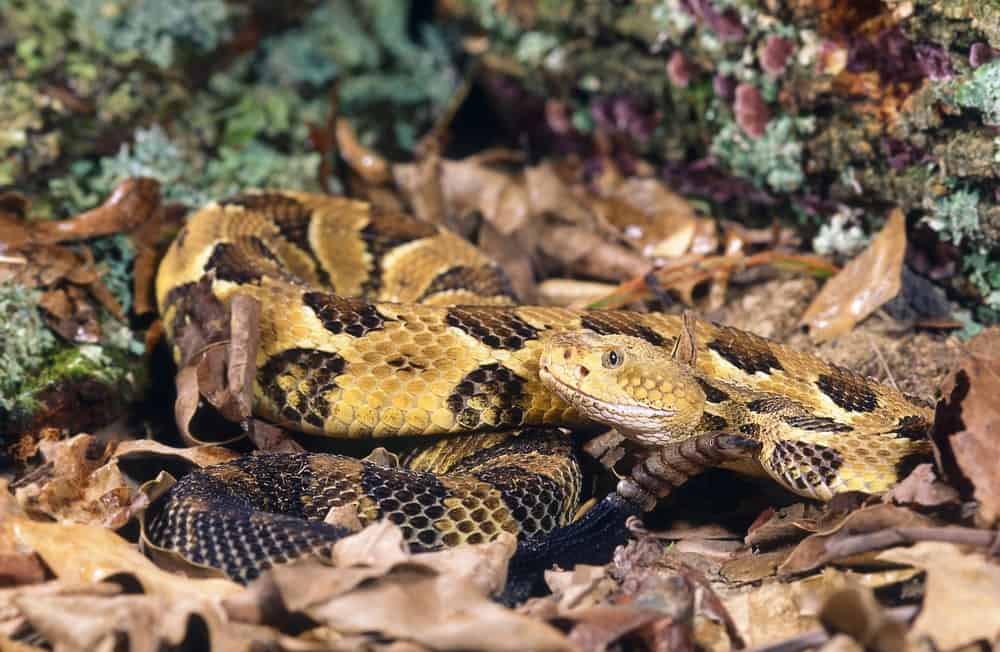
|
Scientific Name: |
Crotalus horridus |
|
Range: |
Statewide except for the western border and southeast corner of Pennsylvania |
|
Size: |
36 – 60 inches The largest venomous species in the state |
|
Description: |
Keeled scales Heavy-bodied Vertical pupils on a large, triangle-shaped head Sometimes have a dark stripe from the eye to the corner of the mouth Yellow phases and dark phases in PA; Yellowish brown to dark brown bodies with dark brown or gray V-shaped bands along the entire body. Tail is solid dark brown, gray, or black with a lighter-colored rattle. |
|
Habitat: |
Upland, mature, and young forests |
|
Diet: |
Small mammals, birds, frogs, and other snakes |
|
Venomous/Non-Venomous: |
Venomous |
Eastern Massasauga
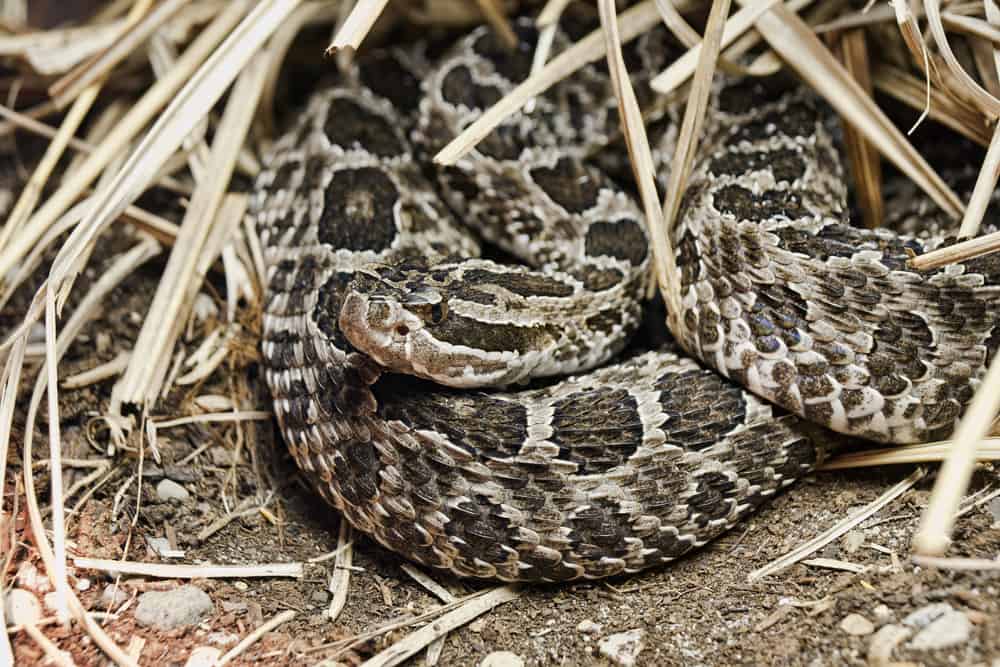
|
Scientific Name: |
Sistrurus catenatus catenatus |
|
Range: |
Butler, Mercer, and Venango Counties in western Pennsylvania |
|
Size: |
18-40 inches |
|
Description: |
Elliptical pupils Small and stocky Gray or grayish-brown body with keeled scales Dark line from the eye to the corner of the mouth Large, dark brown, irregularly shaped blotches down the back and rows of round spots along the sides. The tail has dark rings and a small rattle |
|
Habitat: |
Wetlands, wet meadows, and prairies. Found in wet habitats in spring and fall, and dry habitats in summer |
|
Diet: |
Small mammals, lizards, frogs, other snakes, and invertebrates |
|
Venomous/Non-Venomous: |
Venomous |
Snakes Found in Pennsylvania
The Keystone State doesn’t have the highest diversity of snakes, but you’ll still find an impressive variety for its northeastern location.
There are 21 species of snakes found in Pennsylvania, and nearly all of them are nonvenomous.
Let’s discuss the state’s most common species in detail, and discover all of its native snakes.
Most Common Snakes in Pennsylvania
Memorizing all 21 species native to Pennsylvania is a tall order.
It’s more efficient to spend your time focusing on which species you’re most likely to run into.
According to observations on iNaturalist, the six most abundant snake species in the state, from most to least common, are:
- Eastern Garter Snake – Thamnophis sirtalis sirtalis
- Common Water Snake – Nerodia sipedon
- Dekay’s Brown Snake – Storeria dekayi
- Ring-necked Snake – Diadophis punctatus
- Eastern Rat Snake – Pantherophis alleghaniensis
- Milk Snake – Lampropeltis triangulum
Eastern Garter Snake
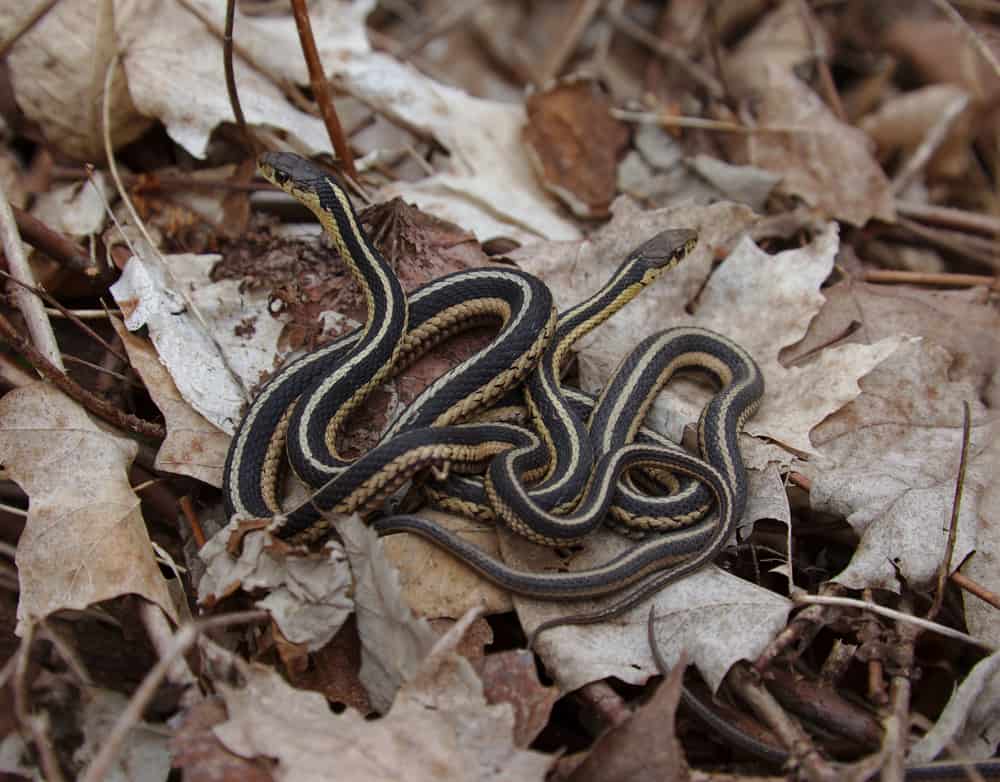
|
Scientific Name: |
Thamnophis sirtalis sirtalis |
|
Range: |
Statewide |
|
Size: |
20-28 inches |
|
Description: |
Round pupils Keeled scales Coloration is variable; green, brown, or black White, tan, yellow, brown, or gray stripes along the spine and sides. The dorsal stripe may be absent There may be rows of black or red spots between the stripes |
|
Habitat: |
Habitat generalists. Often found near sources of water and human homes |
|
Diet: |
Amphibians, earthworms, rodents, birds, and fish |
|
Venomous/Non-Venomous: |
Non-venomous |
Garter snakes’ affinity for suburban gardens has earned them the nickname ‘garden snakes’ in Pennsylvania.
This is a snake species you certainly want to keep around. They’re not aggressive snakes, and they’ll help you keep a healthy garden by eating pests.
Common Water Snake
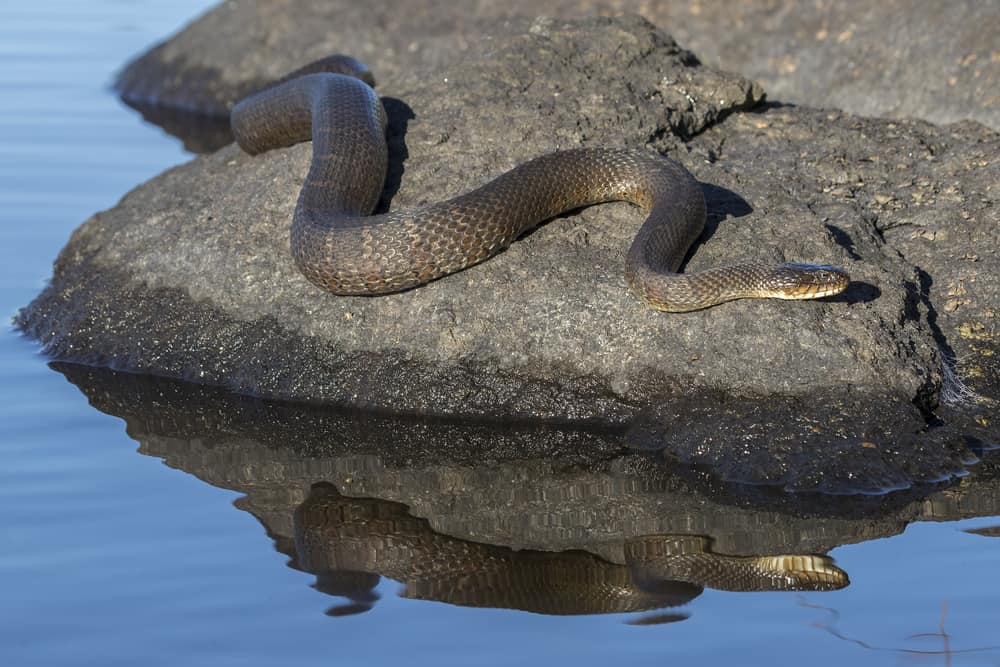
|
Scientific Name: |
Nerodia sipedon Northern Water Snake subspecies Nerodia sipedon sipedon |
|
Range: |
Statewide |
|
Size: |
24-55 inches |
|
Description: |
Round pupils Keeled Scales Heavy bodied species Brown, tan, or gray with brown or reddish-brown bands and blotches along the body Juveniles have more distinct patterns that darken as they age |
|
Habitat: |
Near sources of water, such as lakes, ponds, rivers, canals, swamps, and marshes |
|
Diet: |
Fish, amphibians, small mammals, birds, and invertebrates |
|
Venomous/Non-Venomous: |
Non-venomous |
Dekay’s Brownsnake
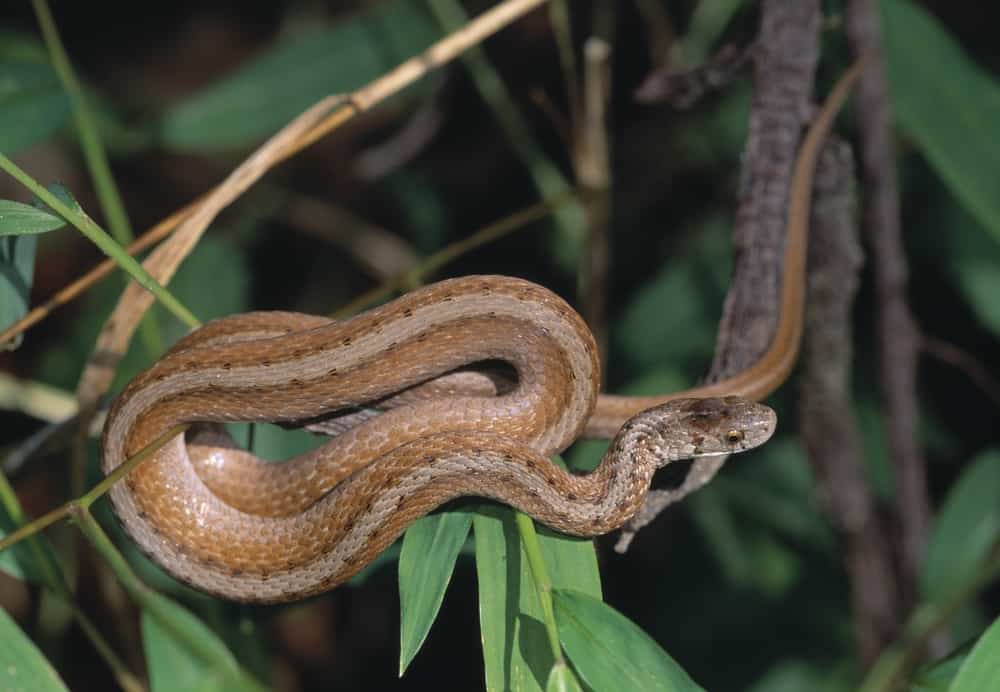
|
Scientific Name: |
Storeria dekayi Northern Brown Snake subspecies Storeria dekayi dekayi |
|
Range: |
Western quarter of the state and most of Southeast and Central Pennsylvania |
|
Size: |
9-13 inches |
|
Description: |
Keeled scales Round pupils Light gray, grayish-brown, or dark brown A lighter dorsal stripe bordered by dark brown or black spots |
|
Habitat: |
A variety of habitats, including woodlands, grasslands, marshes, and urban areas |
|
Diet: |
Slugs, snails, earthworms, and soft insects |
|
Venomous/Non-Venomous: |
Non-venomous |
Ring-necked Snake
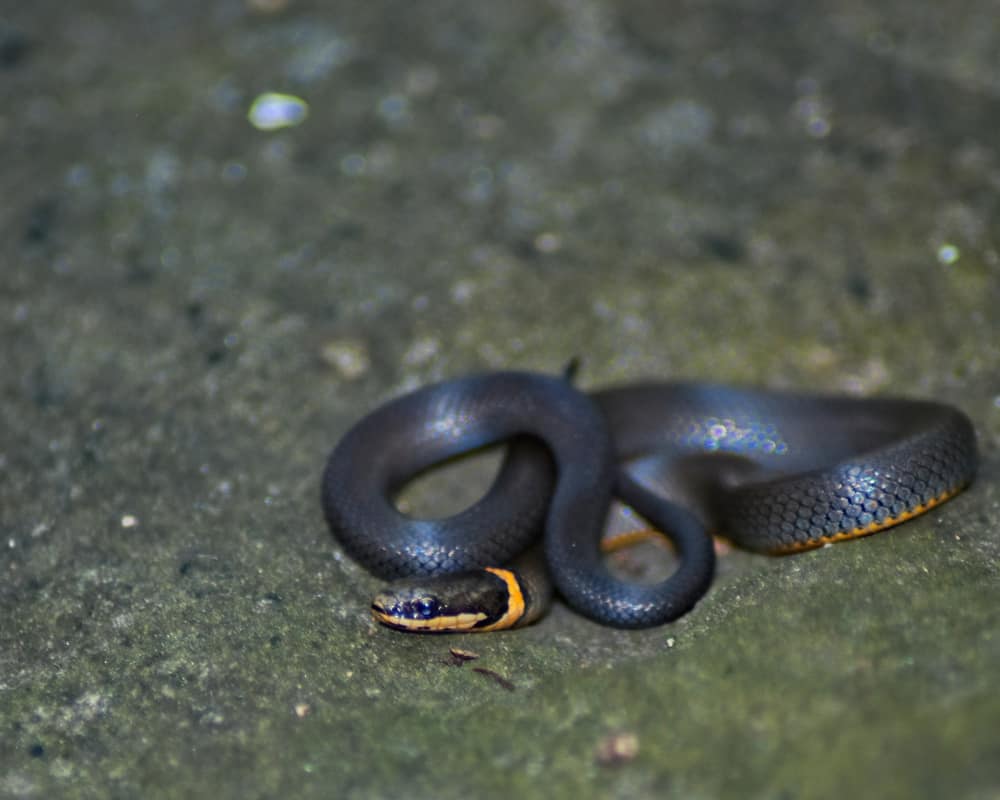
|
Scientific Name: |
Diadophis punctatus Northern Ring-necked Snake subspecies Diadophis punctatus edwardsii |
|
Range: |
Statewide |
|
Size: |
12-15 inches |
|
Description: |
Round pupils Smooth scales Dark gray, blue-gray, or olive-brown Bright orange or yellow neck ring and ventral scales |
|
Habitat: |
A variety of habitats, particularly damp hardwood forests, rocky areas, and fields The northern ring-necked snake is one of the most common species found in PA homes |
|
Diet: |
Earthworms, slugs, and amphibians |
|
Venomous/Non-Venomous: |
Non-venomous |
Eastern Rat Snake
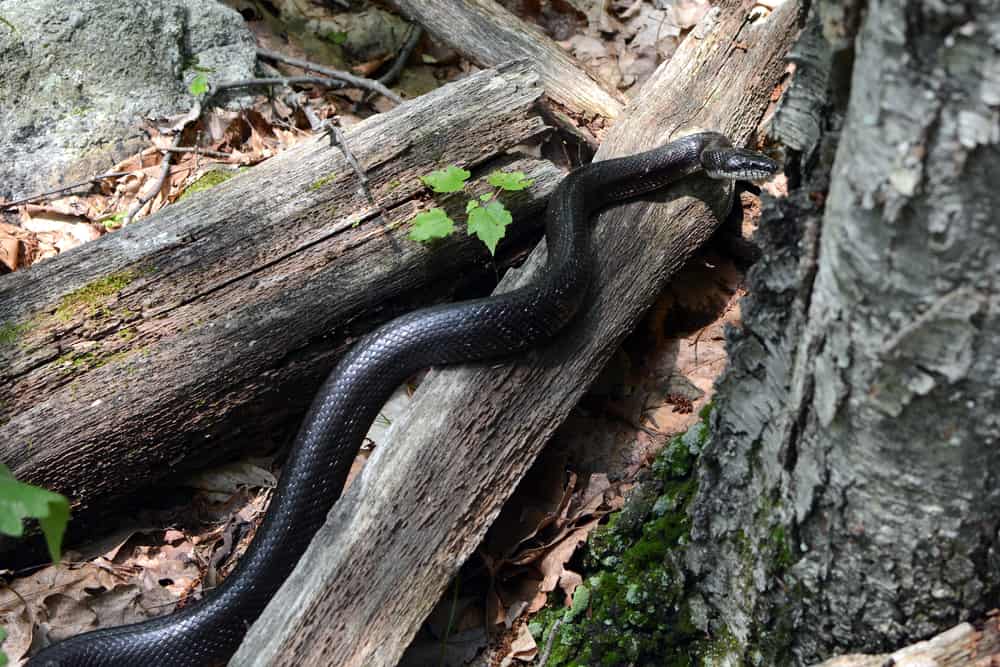
|
Scientific Name: |
Pantherophis alleghaniensis |
|
Range: |
Statewide |
|
Size: |
40 -101 inches |
|
Description: |
Round pupils Slightly keeled scales Solid black or brown with black blotches White lips, chin, throat, and ventral scales. Ventral scales have a checkerboard pattern Juveniles are white or yellow with gray, black, or brown blotches |
|
Habitat: |
Farmlands, forests, fields, and meadows |
|
Diet: |
Rodents, lizards, frogs, birds, and bird eggs |
|
Venomous/Non-Venomous: |
Non-venomous |
The eastern rat snake is commonly called a black rat snake in Pennsylvania.
It’s easy to mistake this species for the northern racer (Coluber constrictor), another black snake species found throughout most of the state.
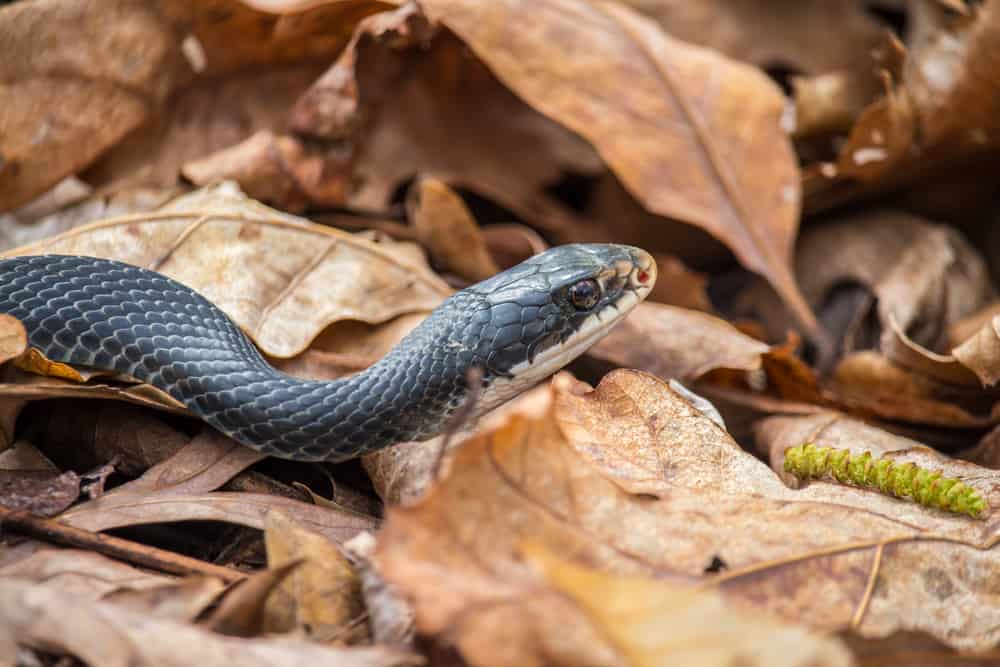
The northern racer has large, smooth, glossy scales, a prominent eyebrow ridge, and dark gray ventral scales.
Eastern Milksnake
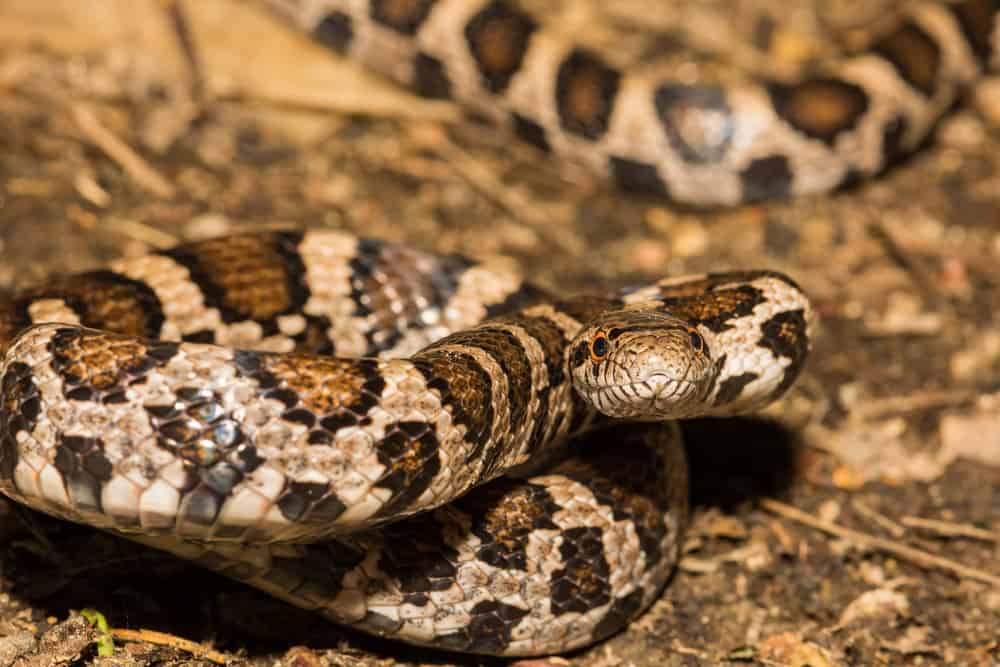
|
Scientific Name: |
Milksnake Lampropeltis triangulum Eastern Milksnake subspecies Lampropeltis triangulum triangulum |
|
Range: |
Statewide |
|
Size: |
24-52 inches |
|
Description: |
Smooth scales Small, blunt head with round pupils A dark V, U, or Y-shaped mark on top of the head Ventral scales have a checkerboard pattern Appearance varies. Typically gray, tan, various shades of brown, or red Large dark brown or reddish-brown blotches outlined in black run down the back and sides |
|
Habitat: |
Various habitats, including forests, farmland, rocky hillsides, and urban areas |
|
Diet: |
Generalists; rodents, reptiles, amphibians, invertebrates, birds, and bird eggs |
|
Venomous/Non-Venomous: |
Non-venomous |
Snakes Native to Pennsylvania
All but three snakes of Pennsylvania are Colubrids.
The Colubridae family is the largest and most diverse snake family.
From a tiny pink snake, like the worm snake, to an intimidatingly large snake, like the rat snake, you’ll find a list of all snake species in the state organized by family and genera below.
Colubridae:
|
Racers |
|
|
Eastern Racer |
Coluber constrictor |
|
Rat Snakes |
|
|
Eastern Ratsnake |
Pantherophis alleghaniensis |
|
Kingsnakes |
|
|
Milk Snake |
Lampropeltis triangulum |
|
Worm Snakes |
|
|
Eastern Worm Snake |
Carphophis amoenus |
|
Water Snakes |
|
|
Common Water Snake |
Nerodia sipedon |
|
Brown Snakes |
|
|
Red-bellied Snake |
Storeria occipitomaculata |
|
DeKay’s Brownsnake |
Storeria dekayi |
|
Earth Snakes |
|
|
Smooth Earth Snake |
Virginia valeriae |
|
Mountain Earth Snake |
Virginia pulchra |
|
Green Snakes |
|
|
Rough Green Snake |
Opheodrys aestivus |
|
Smooth Green Snake |
Opheodrys vernalis |
|
Garter Snakes |
|
|
Ribbon Snake |
Thamnophis sauritus |
|
Common Garter Snake |
Thamnophis sirtalis |
|
Short-headed Garter Snake |
Thamnophis brachystoma |
|
Crayfish Snakes |
|
|
Queen Snake |
Regina septemvittata |
|
Hognose Snakes |
|
|
Eastern Hognose Snake |
Heterodon platirhinos |
|
Kirtland’s Snakes |
|
|
Kirtland’s Snake |
Clonophis kirtlandii |
|
Ring-necked Snakes |
|
|
Ring-necked Snake |
Diadophis punctatus |
Viperidae:
|
Rattlesnakes |
|
|
Timber Rattlesnake |
Crotalus horridus |
|
Massasaugas |
|
|
Eastern Massasauga |
Sistrurus c. catenatus |
|
American Moccasins |
|
|
Eastern Copperhead |
Agkistrodon contortrix |
At-Risk and Endangered Species
There are three species of snakes considered ‘endangered’ in the state of Pennsylvania:
- Kirtland’s Snake – The Kirtland’s snake is a small, elusive species that prefer open, wet habitats. It used to inhabit western Pennsylvania, but no one has seen this snake in the state in decades. Its population has declined due to habitat loss.
When threatened, the Kirtland’s Snake flattens its body.
Image credit: Todd W Pierson via Creativecommons.org - Eastern Massasauga -You can only find these snakes in western PA. They have specific habitat preferences in wetlands near dry fields and meadows. Habitat destruction is the leading cause of their decline.
- Northern Rough Greensnake – The northern rough greensnake was never abundant in Pennsylvania, but is now only found in one southeastern county of the state.
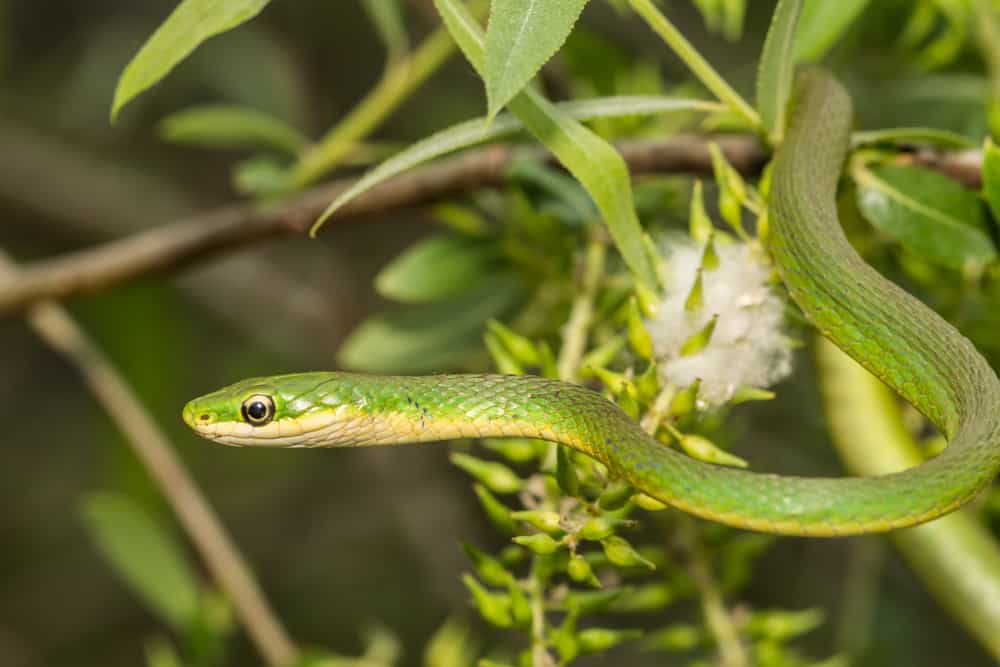
There are 11 species of special concern, meaning they’re in danger of becoming threatened due to declining population sizes, specialized habitats, or unnecessary persecution.
Those species include:
- Queen Snake
- Timber Rattlesnake
- Smooth Greensnake
- Eastern Wormsnake
- Northern Copperhead
- Mountain Earthsnake
- Northern Ribbonsnake
- Common Ribbonsnake
- Shorthead Gartersnake
- Eastern Hognose Snake
- Eastern Smooth Earthsnake
It’s illegal to capture or kill these species.
The only exceptions are the eastern copperhead and timber rattlesnake, which still have restrictions.
What You Need to Know
Snakes aren’t the horrifying creatures they’re made out to be.
They won’t chase or attack you.
Snakes are just as startled by your presence as you are by theirs. They see us as predators, not prey.
Like all wildlife, snakes want to be left alone. They’ll usually give several warning signs before resorting to biting.
Most bites occur when someone is trying to kill, harass, or relocate a snake.
The best way to avoid an unwanted confrontation with a snake is to respect its space.
Coexisting With Pennsylvania Snakes
Snakes play a vital role in Pennsylvania’s ecosystem.
Many animals rely on snakes as a source of food, including birds of prey, foxes, turtles, raccoons, and even other snakes.
They’re also nature’s pest control, helping keep mice, rats, and insect populations in check.
Unless a snake has made its way inside of your home, or you’re in immediate danger, it’s best to put your fears aside and live side-by-side with these marvelous creatures.
Snake Safety
About Venomous Snakes
There are few truly dangerous snakes in Pennsylvania, and venomous bites are extremely rare.
A snake’s venom is primarily used to subdue prey and is only used for protection when the snake is in fear for its life.
Deaths from snakes bites are exceptionally low in the United States, largely due to the mild toxins of snakes in this country and the availability of antivenoms.
If you take extra precautions and leave snakes alone, there’s no need to worry about a bite from these elusive reptiles.
Treading Carefully in Snake Habitat
If you’re spending time in an area known to house snakes, there are several preventative measures you can take to keep you and your loved ones safe.
Most importantly:
- Watch your step
- Keep your pets on a leash
- Stick to paved or worn paths
- Wear sturdy, tall hiking boots and long pants
- Be conscious of where you place your hands
Snakes often hide in tall grass or under wood, rocks, and debris.
If You Encounter a Snake
Snakes are generally shy animals and don’t like to be around people.
Occasionally you may find a snake in your yard or even inside your home.
The crucial thing to remember is not to panic.
If the snake is in a location where it doesn’t pose a threat to you or your loved ones, it’s best to leave it alone.
The same goes for snake eggs. In Pennsylvania, it’s illegal to damage or disrupt a reptile’s nest or eggs.
Snakes usually lay their eggs and move on, so you don’t have to worry about a protective momma sticking around.
When to Call for Help
Reach out to a professional wildlife trapper if you feel uncomfortable removing a snake from your home.
If a venomous snake bites you, call 911 or have someone drive you to the nearest emergency room immediately.
Antivenom is most effective when administered within a few hours.
Stay calm and move as little as possible.
Seek emergency veterinary care if a snake bites your pet.
Useful Resources
Penn State Poison Center: 1-800-222-1222
Contact the American Society for the Prevention of Cruelty to Animals (ASPCA) Animal Poison Control Center at 1-888-426-4435 for advice on what to do if a snake bites your pet.
Your regional Pennsylvania Fish and Boat Commission office will relocate venomous species for you.
Visit WildlifeHelp.org for advice on how to deal with snakes in your area.
Report your snake sightings to The Pennsylvania Amphibian and Reptile Survey (PARS) and discover more in-depth information on PA reptiles and amphibians.
Find a professional in your area with this Free Snake Relocation Directory on Facebook.
Related Articles to Pennsylvania Snake Identification
If you’re excited about identifying snakes in the wild, you might be interested in these guides:
Don’t forget to take a look at more snake articles written by reptile pros.
Have you seen these snakes in the wild? Let us know in the comments!
